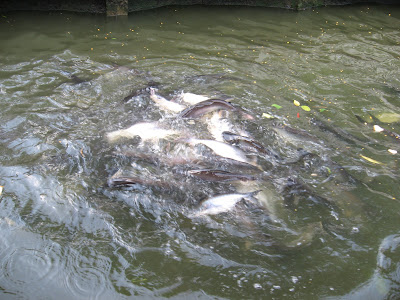Bangkok's Klongs (Canals)
Today, we are going to explore Bangkok's klongs. Visitors to Bangkok in the early part of the 20th century saw canals crisscrossing the city and providing the chief means of moving around it, all feeding off the Chao Praya river where tradeboats came in. These klongs gradually succumbed to being filled in and turned into roads, generating the gridlock for which Bangkok has become notorious. But still in the heart of Bangkok lies a huge network of klongs where hundreds of people go about their daily lives, just the other side of the Chao Praya river from the huge skyscrapers of the financial district but seemingly a world away, Bangkok’s klongs are a magical place to visit and are a remarkable contrast to the frenetic pace of the rest of the city.
Our car arrived and we were only a little perturbed to discover it was a Volvo. Thankfully there was no hat on the back shelf.
We are taken to Saphan Taksin, the riverboat and BTS Skytrain stop where we are to meet our longtail boat and boatman. For Brisbane residents, it's interesting to know there is not just one River City!
Bangkok was founded on klongs. It was once called the "Venice of the East." They're not so important these days, the canals, but they do have great charm, and there's still life on them.
Riding a longtail boat is a bit of an adventure in itself - the distinct narrow, beautifully crafted wooden hull is powered by the famous longtail engine - basically a car engine with a propeller shaft attached. The longtails were made famous by the chase sequences in the James Bond flick The Man With The Golden Gun, and they can shift when the boatman opens up the throttle.
To enter the klongs, we pass through a lock which was built to prevent the houses along the canals flooding when the main river rises during the high tides of the monsoon season. Once through there (and sometimes it can take 15 minutes or so of waiting) we enter into the network of canals proper.
One enterprising lady who is a one-woman floating market, waited in her little boat for us to come along to buy some trinkets. She’s was very friendly and spoke very good English.
There are plenty of fish in the klongs and they will fight for a crust of bread if you throw it over the side as you go by.
The canals are quite narrow only about seven metres across. As we pass by, we notice there are numerous temples, shrines, restaurants and schools and we can see many of the locals going about their day.
Clearly there are dangerous sections of the klong network. Approaching some sections where visibility was reduced, our boatman would reduce power and sound his fog horns, wakening everyone in a five hundred metre radius.
I couldn't help but notice the power poles set in the middle of the klongs. I can't help but imagine the difficulty of the linesmen who would have to scale them to repair the cables.
And the most basic of services: garbage collection is carried out by a specially adapted barge and a team of cheery men who are only to happy to give us a wave as they go past on their daily duties.
Lining the canals are all manner of houses from the most dilapidated to the impressively grand, all cheek by jowl with one another.
Subscribe to:
Post Comments (Atom)
Blog Archive
-
▼
2008
(50)
-
▼
April
(29)
-
▼
Apr 11
(6)
- The robbed that smiles, steals something from the ...
- And though you live in a palace of gold, or sleep ...
- Nemo ante mortem beatus - Nobody is blessed before...
- Faith is the bird that sings when the dawn is stil...
- Rivers are roads which move, and which carry us wh...
- "What we are today comes from our thoughts of yest...
-
▼
Apr 11
(6)
-
▼
April
(29)















No comments:
Post a Comment